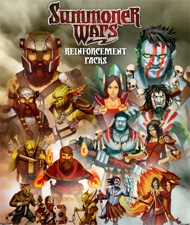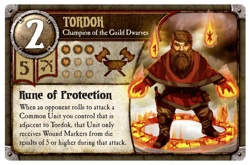
|
About OgreCave and its staff
|

|
by Lee Valentine
Grungor's Charge and Rukar's Power are two "Reinforcement Packs" for Summoner Wars ("SW"), the card-based tactical wargame by Colby Dauch and the fine folks at Plaid Hat Games. Typically I review individual expansions separately, but each of these serves a similar purpose – to update the decks provided in the two basic Summoner Wars boxed sets – so I have decided to review them together. Each Reinforcement Pack features 32 new non-random cards, 13 cards each for two different races, plus six mercenary cards which can be added to any SW deck. Of these, each race has three new champions to choose from, and five copies each of three different units. Within a given expansion deck there is one copy of a new mercenary champion and five copies of a new common mercenary unit. Rukar's Power adds units for the Tundra Orcs and the Phoenix Elves, while the Grungor's Charge box adds units for the Guild Dwarves and the Cave Goblins. All of these units are intended to be used with SW's optional custom deck-building rules, and as such, they finally allow you to break away from just using the pre-canned army decks on the market, which gives the game a bit more life.
Army-by-Army Highlights
Speaking of the Goblins, one of my favorite new common units is the Beast Rider. It has a large enough movement that it can cross the board in a single turn. Of course, the board is often clogged, but if you can punch a hole through then these units can quickly be brought to bear against the enemy's Summoner or his ranged units that have been hiding at a distance. Climbers are another new Goblin common that can climb over walls, again adding some badly needed tactical flexibility to the game. Some of the new champions do not count against the total number of units that you can move or attack with during your turn, expanding on a concept already present in the original Goblin army units.
The Orcs have one new champion called Bragg who makes most of your already feared Orcish Events even more difficult to handle for your opponent. The new common unit, the Charger, can, as its name implies, maneuver around the board a bit faster than other units, occasionally surprising an unwary opponent. Overall, the other additional Orc units were tough and brutal. As noted earlier, each Reinforcement Pack comes with five copies of a new common Mercenary and one new champion. In Rukar's Power, the Spear Grounders ability to attack units diagonally allows for greater defensive play. Whether walking into the middle of the fray or attacking between two diagonally touching walls, this allows the Spear Grounder to attack units who are otherwise incapable of responding in kind (because most SW units can attack only orthogonally adjacent targets). The new mercenary Champion Magos increases your hand size from five to seven cards. While this sounds phenomenal, the fact that he is himself expensive to summon, and given that SW decks are so small, this boost could be substantial but probably short-lived (either because Magos will become a target or you will simply run out of deck to draw). However, he is the only champion I have seen whose presence really helps you to summon a second costly champion even more quickly (by increasing available cards to convert to Magic). In Grungor's Charge, new Vermin mercenaries are tiny versions of the Mercenary Champion Khan Queso, and like him, they are plague bearers capable of damaging adjacent units. Malevolence is a new champion who is among the most expensive, tough, and hard hitting of any units in the game, but each time she attacks she damages herself, meaning that she is perhaps more suitable for killing off your enemy's champions or Summoner than his penny ante commons.
Components and Packaging The card boxes themselves are sturdy and have unit lists on the back of each box, so that you know exactly what you are getting. Additionally, the Reinforcement Pack tuck boxes are small enough that you can squeeze them into your SW starter boxes, in case you want to keep the expansion cards stored separately from the starter deck cards. That was a nice touch. Harkening back to the "Hot Lava Death" reference to the Volcarren Wastelands expansion for Heroscape, each of the two tuck boxes has a speech bubble from Colby Dauch. One says, "Eat your greens, not your neighbors." Note, there's no punctuation omitted, that wasn't an instruction not to eat your neighbor's greens. The other box says "Your yogurt has expired." No, this will not make or break your decision to purchase these items, but it is one more reason to visit Colby Dauch at the Plaid Hat booth at your favorite convention to hear the stories behind these mysterious turns of phrase.
Conclusions When I initially played SW, I felt the board was extremely claustrophobic compared to a traditional miniatures game. Often miniatures would appear on the map in the spot they would eventually die in, or would live out their existence within just one or two spaces of the spot where they were summoned. Even with these expansion packs, this is still largely true. However, the units that can attack diagonally or which have substantially greater mobility than standard SW units proved interesting tactical additions to the game. This was refreshing, and added noticeably to my enjoyment of the game. While I liked the new Goblin champions, I was not pleased with the interaction of the Goblin events with the new Goblin common units and Mercenaries. This is too bad, because I liked the design work on both these Reinforcement Packs, but it makes me feel that getting Grungor's Charge is less exciting if you regularly play a Goblin army. That said, I can recommend both of these expansions, Rukar's Power a bit more strongly than Grungor's Charge.
For Retailers You may have an additional concern if you care to display these on a peg board. While the decks do have a hang hole tab, the hole is appreciably smaller than on some other card boxes.
Lee's Ratings:
Links
|
||||
 Grungor's Charge and Rukar's Power
Grungor's Charge and Rukar's Power One
potential limitation of SW is the fact that the spells or
"Events" that come in a standard SW deck have to be used every
time you stack a specific army. Because some of the Phoenix Elves
events can only be used on Phoenix Elves characters, this army can less
readily employ Mercenary units without watering down the flexibility of
their Events. This limitation manifested itself seriously in the design
of the new Goblin reinforcements. None of them cost 0 to summon, and
yet many of the Goblin Events work only on Cave Goblins with a 0 cost,
meaning that inclusion of a substantial number of Mercenary units or
even the new Goblin units waters down the effectiveness of your Events.
If you add too many new units you will view the Goblin Events largely as
chaff, clogging up the works, and you will feel irritated that you were
forced to stack some of these Events. They have a limited use, as all
cards can be discarded to Build Magic to summon more units, but this
still left a sour taste in my mouth. I would really like to see
alternate Event sets that can be swapped in, particularly for the
Goblins.
One
potential limitation of SW is the fact that the spells or
"Events" that come in a standard SW deck have to be used every
time you stack a specific army. Because some of the Phoenix Elves
events can only be used on Phoenix Elves characters, this army can less
readily employ Mercenary units without watering down the flexibility of
their Events. This limitation manifested itself seriously in the design
of the new Goblin reinforcements. None of them cost 0 to summon, and
yet many of the Goblin Events work only on Cave Goblins with a 0 cost,
meaning that inclusion of a substantial number of Mercenary units or
even the new Goblin units waters down the effectiveness of your Events.
If you add too many new units you will view the Goblin Events largely as
chaff, clogging up the works, and you will feel irritated that you were
forced to stack some of these Events. They have a limited use, as all
cards can be discarded to Build Magic to summon more units, but this
still left a sour taste in my mouth. I would really like to see
alternate Event sets that can be swapped in, particularly for the
Goblins. The Dwarves get, perhaps, the biggest thematic kick with the
introduction of their new siege engine, the common Ballista. It is a
ranged unit that can only either move or attack, but it's tougher than a
typical ranged unit and it does additional damage against walls, really
feeding into a core strategy already present in the Dwarven army. While
the new Dwarven champions pack a fair bit of punch, their abilities are
not quite as unusual as those found in the original Dwarven champions.
The new Dwarven champion Tordok has an ability that I would like to
explore more, in that he makes common units adjacent to him more
difficult to damage. This could really allow you to turtle up if you
play your units down in the right formation.
The Dwarves get, perhaps, the biggest thematic kick with the
introduction of their new siege engine, the common Ballista. It is a
ranged unit that can only either move or attack, but it's tougher than a
typical ranged unit and it does additional damage against walls, really
feeding into a core strategy already present in the Dwarven army. While
the new Dwarven champions pack a fair bit of punch, their abilities are
not quite as unusual as those found in the original Dwarven champions.
The new Dwarven champion Tordok has an ability that I would like to
explore more, in that he makes common units adjacent to him more
difficult to damage. This could really allow you to turtle up if you
play your units down in the right formation.